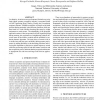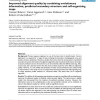11 search results - page 2 / 3 » SARDNET: A Self-Organizing Feature Map for Sequences |
WIAMIS
2009
IEEE
13 years 11 months ago
2009
IEEE
An adaptive, invariant to user performance fluctuation or noisy input signal, gesture recognition scheme is presented based on Self Organizing Maps, Markov Models and Levenshtein...
AAAI
2004
13 years 6 months ago
2004
This paper deals with automatically learning the spatial distribution of a set of images. That is, given a sequence of images acquired from well-separated locations, how can they ...
KES
2004
Springer
13 years 10 months ago
2004
Springer
– This paper describes a text categorization approach that is based on a combination of a newly designed text representation with a kNN classifier. The new text document represen...
EVOW
2008
Springer
13 years 6 months ago
2008
Springer
We present a study on the use of soft computing techniques for object tracking/segmentation in surveillance video clips. A number of artificial creatures, conceptually, "inhab...
BMCBI
2006
13 years 4 months ago
2006
Background: Protein sequence alignment is one of the basic tools in bioinformatics. Correct alignments are required for a range of tasks including the derivation of phylogenetic t...


